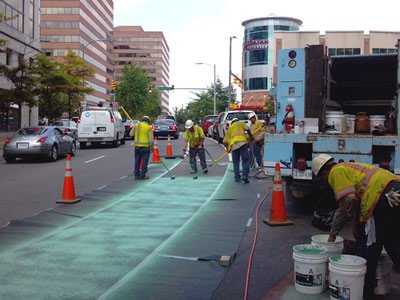The pace of planning and implementing significant bicycle and pedestrian improvements in the Washington region has picked up in recent years, according to a major four-year update of the region's Bicycle and Pedestrian Plan, adopted by the Transportation Planning Board last week.
The 200-plus-page document pulls together key regional metrics showing that construction of new infrastructure is up, that policies and planning efforts to promote bicycle and pedestrian improvements are now all but ubiquitous, and that more and more people in the region are using non-motorized transportation modes, especially bicycling, to meet their daily needs.
According to the plan, the region has added nearly 200 new miles of major bicycle lanes and shared-use paths since 2005, bringing the total to more than 700. An increasingly diverse and innovative array of facilities, including protected bike lanes, secured bike parking, and the popular Capital Bikeshare system, are helping to make bicycling safer and more attractive to more people.
|

|
|
Flickr/beyonddc
|
A growing number of policies and planning efforts at the local, state, and regional levels are helping to support these efforts. They include Complete Streets and Safe Routes to School policies, new bicycle and pedestrian master plans, and updated roadway and bikeway design guides. The Regional Transportation Priorities Plan, adopted by the TPB last year, is another example, calling for more bicycle and pedestrian infrastructure, especially as a way to improve access to transit stations and enhance circulation in regional Activity Centers.
These planning and implementation efforts appear to be paying off. Since 2000, the share of area commuters who bike to work is up in every jurisdiction in the region, with Arlington, Alexandria, and the District of Columbia seeing the steepest increases. Bike commuting in the District more than tripled between 2000 and 2012.
This building momentum shows no sign of slowing down. The updated Bicycle and Pedestrian Plan also details the hundreds of capital improvements, studies, actions, and strategies that the region collectively proposes to carry out by 2040 to increase bicycling and walking.
Next year alone, the region is expected to spend about $84 million on major bicycle and pedestrian improvements, nearly four times more than in 2010, the last time the plan was updated. And some 1,600 miles of new or upgraded bicycle and pedestrian facilities are planned by 2040, about 600 more than in the 2010 update. The planned improvements are expected to account for at least 3% of all spending regionwide on new transportation infrastructure through 2040.
The TPB updates the Bicycle and Pedestrian Plan every four years with the help of a subcommittee made up of local bicycle and pedestrian planners from around the region. The plan is meant to serve as a regional clearinghouse of information on key trends and best practices to help inform local planning and decision making.
The plan also serves as a centralized source of information on major planned improvements in the region, including those for which funding has yet to be identified. Periodically, the Bicycle and Pedestrian Subcommittee draws from the database to develop a list of the top unfunded improvements from a regional perspective. The listing can also be used to identify projects to fill key remaining gaps in the existing or planned network, like a potential "bike beltway" providing circumferential travel options for bicyclists.
New in this year's update is an online summary and visualization of the plan, with highlights of key data and metrics, maps of planned projects, links to additional outside resources, and an online access point for the database of planned projects.
Related Links